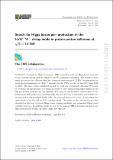Search for Higgs boson pair production in the bbW+W− decay mode in proton-proton collisions at √𝑠 = 13 TeV
Author(s)
Hayrapetyan, A.; Tumasyan, A.; Adam, W.; Andrejkovic, J. W.; Bergauer, T.; Chatterjee, S.; Damanakis, K.; Dragicevic, M.; Escalante Del Valle, A.; Hussain, P. S.; Jeitler, M.; Krammer, N.; Liko, D.; Mikulec, I.; Schieck, J.; Schöfbeck, R.; Schwarz, D.; Sonawane, M.; ... Show more Show less
Download13130_2024_Article_24130.pdf (1.709Mb)
Publisher with Creative Commons License
Publisher with Creative Commons License
Creative Commons Attribution
Terms of use
Metadata
Show full item recordAbstract
A search for Higgs boson pair (HH) production with one Higgs boson decaying to two bottom quarks and the other to two W bosons are presented. The search is done using proton-proton collisions data at a centre-of-mass energy of 13 TeV, corresponding to an integrated luminosity of 138 fb−1 recorded by the CMS detector at the LHC from 2016 to 2018. The final states considered include at least one leptonically decaying W boson. No evidence for the presence of a signal is observed and corresponding upper limits on the HH production cross section are derived. The limit on the inclusive cross section of the nonresonant HH production, assuming that the distributions of kinematic observables are as expected in the standard model (SM), is observed (expected) to be 14 (18) times the value predicted by the SM, at 95% confidence level. The limits on the cross section are also presented as functions of various Higgs boson coupling modifiers, and anomalous Higgs boson coupling scenarios. In addition, limits are set on the resonant HH production via spin-0 and spin-2 resonances within the mass range 250–900 GeV.
Date issued
2024-07-31Department
Massachusetts Institute of Technology. Department of PhysicsJournal
Journal of High Energy Physics
Publisher
Springer Berlin Heidelberg
Citation
The CMS collaboration., Hayrapetyan, A., Tumasyan, A. et al. Search for Higgs boson pair production in the bbW+W− decay mode in proton-proton collisions at √𝑠 = 13 TeV. J. High Energ. Phys. 2024, 293 (2024).
Version: Final published version